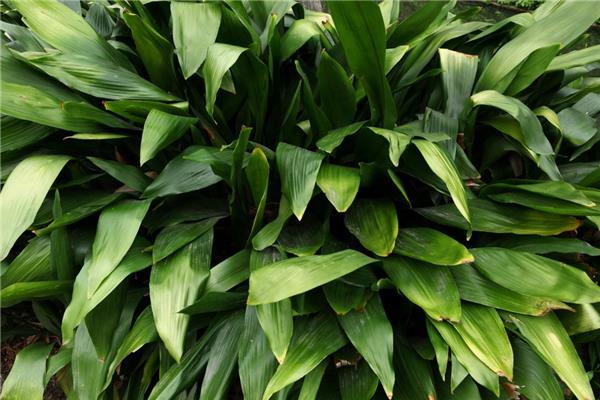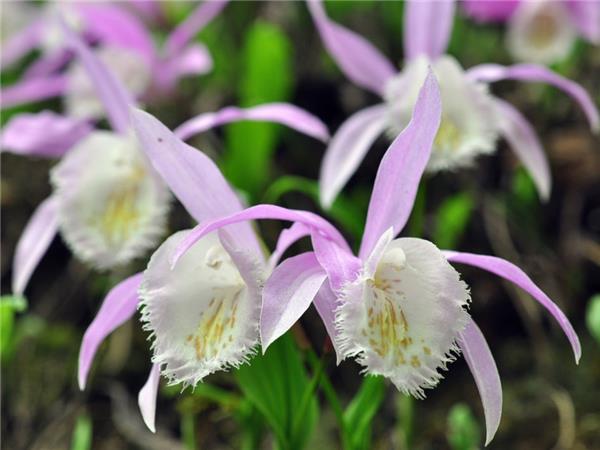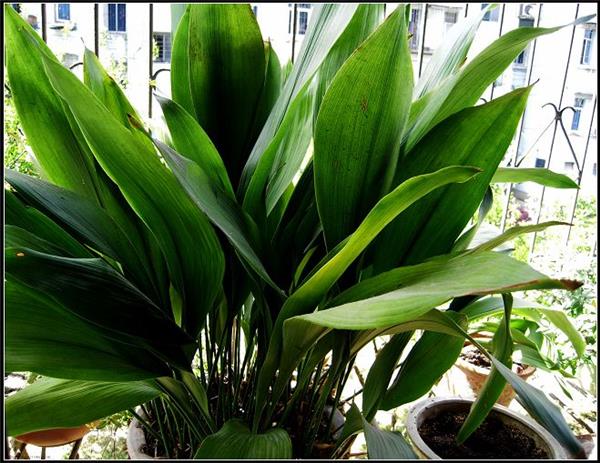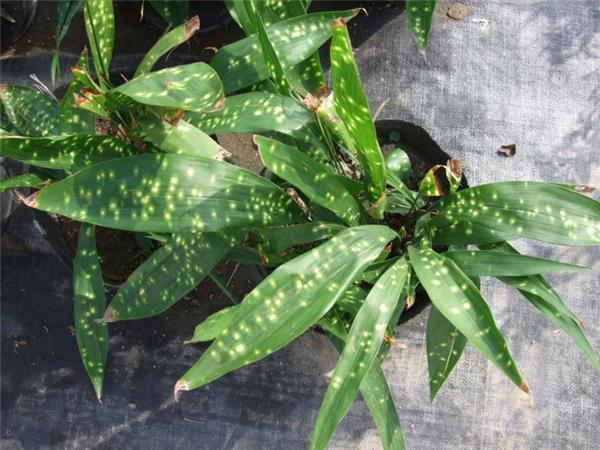What is Spider holding Egg? introduction to the knowledge of Spider holding Egg
Spider holding egg is a kind of perennial herbaceous plant, because the four seasons are evergreen, and the flower shape is beautiful and unique, so it has high ornamental value, and it is a kind of potted ornamental plant with high popularity.

Morphological characteristics of spiders holding eggs
Perennial evergreen herbs. Rhizome subTerete, 5-10 mm in diam., articulate and scaly.
Leaves solitary, 1-3 cm apart, rectangular-circular-lanceolate, lanceolate to subelliptic, 22-46 cm long and 8-11 cm wide, apex acuminate, base cuneate, margin ±crisped, green on both surfaces, sometimes with slightly yellow-white spots or stripes; petiole conspicuous, stout, 5-35 cm long.
Total pedicel 0.5-2 cm long; bracts 3-4, of which 2 are located at the base of the flower, broadly ovate, 7-10 mm long, ca. 9 mm wide, light green, sometimes with purple spots; perianth campanulate, 12-18 mm long, 10-15 mm in diam., outside purplish or dark purple, lower inner surface lavender or dark purple, upper 6-8-lobed; perianth tube 10-12 mm long. Lobes subtriangular, extending or curved outward, 6-8 mm long and 3.5-4 mm wide, apex obtuse, margin and upper part of the inside light green, inner surface with particularly thick fleshy ridges, 2 thin and long in the middle, 2 thick and short on both sides, middle up to 1.5 mm high, purplish red; stamens 6-8, arising from perianth tube near base, below stigma Filaments short, anthers elliptic, ca. 2 mm; pistil ca. 8 mm tall, ovary almost not inflated; style unarticulated; stigma peltate, orbicular, 10-13 mm in diam., purplish red, 3-4-parted on top, cracks more or less protruding on both sides, central part slightly convex, lobe apex retuse, margin often revolute.

Home Application of Spider holding Egg
1, watch: the spider holds the egg leaf shape is tall and straight, the leaf color is dark green bright, the posture is graceful, elegant and has the demeanor, at the same time it grows strong, the adaptability is strong, extremely resistant to shade, it is an excellent shade-loving foliage plant for indoor greening decoration, suitable for home and office layout. It can be watched alone or arranged with other flowering plants to set off the freshness and beauty of other flowers. In addition, it is also an excellent leaf material for modern flower arrangement.
2, fresh air: plants have a certain role in fresh air, spider holding eggs can absorb formaldehyde, carbon dioxide and hydrogen fluoride also have a certain absorption effect, and can also absorb certain dust. and spiders hold eggs shade-resistant, strong adaptability, not easy to diseases and insect pests, is a good indoor greening, air purification plants.
3. The value of traditional Chinese medicine: traditional Chinese medicine generally uses the rhizome of spiders to hold eggs, which can be collected in the four seasons, dried in the sun or used freshly, with the effect of promoting blood circulation and dispersing blood stasis, tonifying deficiency and relieving cough, generally used for fall injury, rheumatism, low back pain, lung deficiency cough, hemoptysis and so on.

The Culture method of Spider holding Egg
Water and fertilizer: like humid environment. During the growth period, water should be often sprayed to the plant and its surroundings, which can improve the relative humidity of the air, and be conducive to the germination of new buds and the emergence of new leaves. When the air is too dry, the leaves will lose their luster and become dry. Topdressing nitrogen-based fertilizer once a month in the growing season can make the leaves more green and lovely and promote the germination of new buds in rhizomes.
Temperature: like warmth, the most suitable temperature for growth is 20: 25. Stop growing when it is below 10 °. It is more hardy and has the strongest cold tolerance among evergreen foliage plants. It can endure the absolute low temperature of-9 °in winter, and the leaves can remain green at about 0 °. As long as it is moved indoors, the plant can survive the winter safely and maintain a good ornamental property. However, the cold resistance of the species with speckled leaves is slightly poor, and the ambient temperature can be kept above 10 °when overwintering. It is not very resistant to high temperature, and the leaf tip is easy to wither when the temperature is higher than 35 ℃. Measures such as shading, environmental water spraying and ventilation should be taken to reduce the brew.
Turn the basin: turn the basin once every 3-4 years. Strong growth, loose soil requirements, but like loose, fertile, well-drained soil, avoid clayey soil. When the basin soil is too sticky, it is easy to get too wet and stagnant, resulting in poor plant growth, even rotten roots and death. The matrix can be prepared with rotten leaf soil, peat soil, garden soil, coarse sand or rice chaff ash and other materials.
Pest control: there are diseases and insect pests such as leaf blight, root rot and shell insects. Among them, the harm of shell insects is particularly serious, when the ventilation is poor, it will be covered with petioles and leaf back, and produce a little macula on the leaf surface, which not only affect plant growth, but also make ornamental worse, so attention should be paid to prevention and control.

The flower pattern of the spider holding egg is very unique and has a distinctive ornamental effect, but if it is not cultured properly, it may cause the dilemma that it cannot blossom, and it will not be able to play the role of watching flowers, so we should pay attention to some necessary conservation measures in the process of breeding.
The flower pattern of the spider holding egg is very unique and has a distinctive ornamental effect, but if it is not cultured properly, it may cause the dilemma that it cannot blossom, and it will not be able to play the role of watching flowers, so we should pay attention to some necessary conservation measures in the process of breeding.
Related
- Wuhan Hospital Iron Tree Blooming Result Was Instantly Frightened by the Gardener Master
- Which variety of camellia is the most fragrant and best? Which one do you like best?
- What is the small blue coat, the breeding methods and matters needing attention of the succulent plant
- Dormancy time and maintenance management of succulent plants during dormancy
- Minas succulent how to raise, Minas succulent plant pictures
- What are the varieties of winter succulent plants
- How to raise succulent plants in twelve rolls? let's take a look at some experience of breeding twelve rolls.
- Attention should be paid to water control for succulent plants during dormant period (winter and summer)
- Watering experience of twelve rolls of succulent plants
- Techniques for fertilizing succulent plants. An article will let you know how to fertilize succulent plants.



